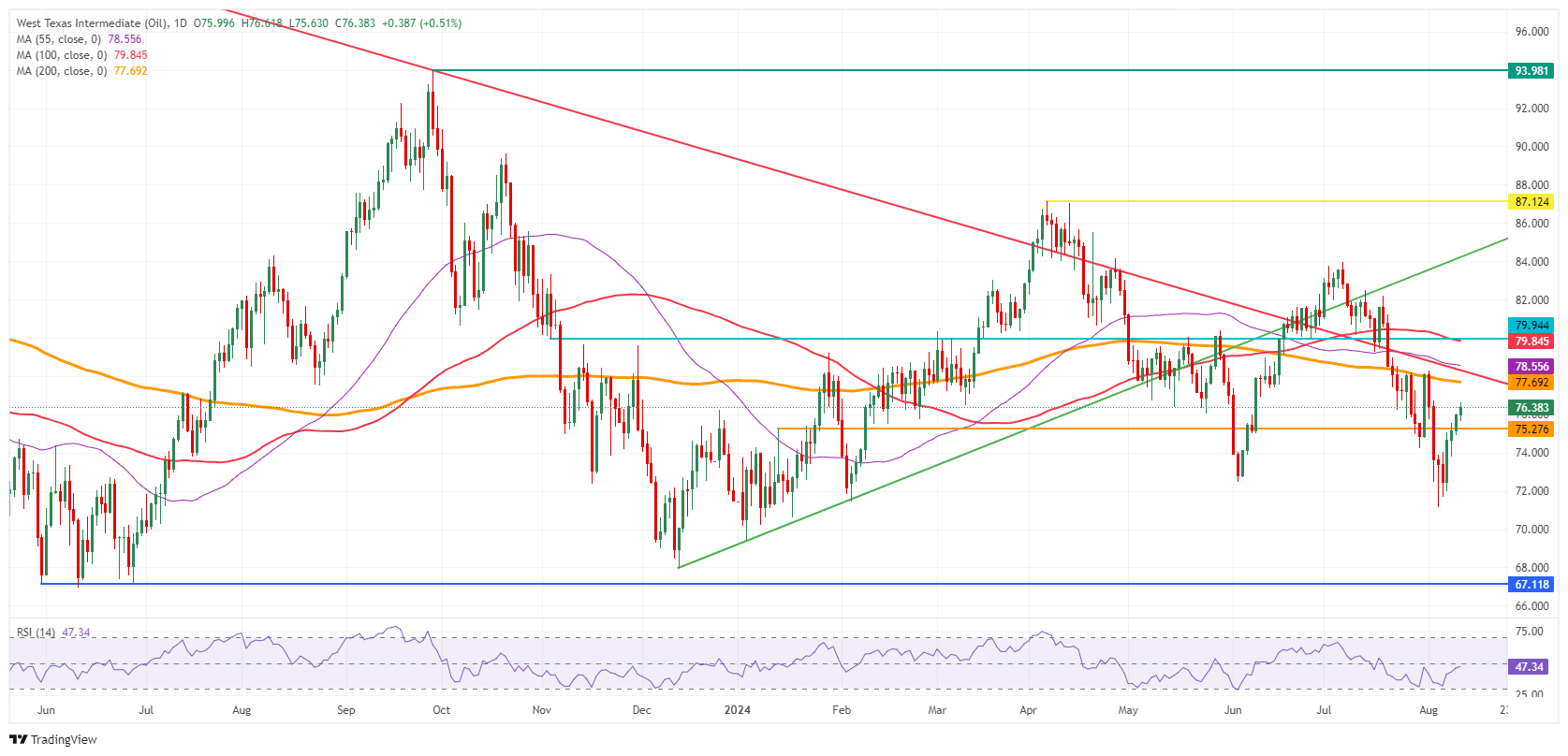- Oil prices rose for the fourth consecutive day on Monday.
- Traders are anticipating a bullish outlook, with demand in Asia picking up.
- The US Dollar Index is trading at a crucial level after being glued to it since last week.
Oil prices are up for the fourth day in a row on Monday. Oil traders are sending crude oil prices higher on the assumption that the monthly report from the Organization of the Petroleum Exporting Countries (OPEC) will still have a bullish tone. Certainly, recent price increases are seen from Saudi Arabia to Asia and Russia committed to meeting its production quota by firmly reducing its output during August and September. Volatility is expected to increase with the International Energy Agency (IEA) report on Wednesday, which is often a bit more dovish than that of OPEC.
The US Dollar Index (DXY), which tracks the performance of the US Dollar against six major currencies, continues to struggle and is trading near the crucial level it was at after Monday’s rough ride in the markets last week. The DXY looks set to orbit around this level until the first catalyst, which will likely be the US Consumer Price Index (CPI) report for July scheduled for Wednesday. If that report reveals a rise in inflation, the market rally would favor a stronger US Dollar.
At the time of writing, WTI crude oil is trading at $76.25 and Brent crude at $79.72
Oil News and Market Movers: Reports to Guide the Markets
- This week begins with OPEC’s monthly report on Monday, normally expected around midday during European trading hours.
- Bloomberg reports that U.S. refiners are prepared to cut output, with the largest producer reporting it will operate its plants at just 90% of capacity. That level is the lowest since 2020.
- Reuters reports that Saudi Aramco will supply almost 2 million fewer barrels in September than it will in August.
- Although Middle East headlines have moved somewhat into the background, tensions are still present, and the element still needs to be considered as a tail risk for further upside.
Oil Price Technical Analysis: Crucial Recovery Point
Oil prices are moving higher, with several traders buying the dip that took place last week. This move is expected to slowly but surely start to fade under the pressure of profit-taking along the way. The OPEC and IEA report could be the catalyst for that turnaround, along with possible price action turning around just before or at the 200-day simple moving average near $77.69.
On the upside, the crucial level near $75.27 has been reclaimed by the bulls, which will now act as a support level for a retracement towards the 200-day simple moving average (SMA) at $77.69. The other two major moving averages are very close with the 55-day SMA at $78.55 and the 100-day SMA at $79.84.
The Relative Strength Index (RSI) has bounced on the daily chart, meaning there is room for a downtrend again. Looking down, the first level to watch is $72.00. Once a new low for August is printed on the charts, another leg lower would not rule out $68.00 or even $67.11, an 18-month low.
WTI Crude Oil Daily Chart
WTI Oil FAQs
WTI crude oil is a type of crude oil sold on international markets. WTI stands for West Texas Intermediate, one of three main types that include Brent and Dubai crude. WTI is also known as “light” and “sweet” for its relatively low gravity and sulfur content, respectively. It is considered a high-quality oil that is easily refined. It is sourced in the United States and distributed through the Cushing hub, considered “the pipeline crossroads of the world.” It is a benchmark for the oil market and the price of WTI is frequently quoted in the media.
Like all assets, supply and demand are the main factors determining the price of WTI crude oil. As such, global growth can be a driver of increased demand and vice versa in the case of weak global growth. Political instability, wars and sanctions can disrupt supply and impact prices. Decisions by OPEC, a group of large oil producing countries, are another key driver of price. The value of the US Dollar influences the price of WTI crude oil, as oil is primarily traded in US Dollars, so a weaker Dollar can make oil more affordable and vice versa.
The weekly oil inventory reports published by the American Petroleum Institute (API) and the Energy Information Agency (EIA) influence the price of WTI oil. Changes in inventories reflect fluctuations in supply and demand. If the data show a decrease in inventories, it may indicate an increase in demand, which would push up the price of oil. An increase in inventories may reflect an increase in supply, which pushes down prices. The API report is published every Tuesday, and the EIA report the following day. Their results are usually similar, with a difference of 1% between them 75% of the time. The EIA data is considered more reliable because it is a government agency.
OPEC (Organization of the Petroleum Exporting Countries) is a group of 13 oil-producing nations that collectively decide on member countries’ production quotas at biennial meetings. Their decisions often influence WTI oil prices. When OPEC decides to reduce quotas, it can restrict supply and drive up oil prices. When OPEC increases production, the opposite effect occurs. OPEC+ is an expanded group that includes ten other non-OPEC countries, most notably Russia.
Source: Fx Street
I am Joshua Winder, a senior-level journalist and editor at World Stock Market. I specialize in covering news related to the stock market and economic trends. With more than 8 years of experience in this field, I have become an expert in financial reporting.








